Optimization of a Faraday Cup Collimator for Electric Propulsion Device Beam Study: Case of a Hall Thruster
Abstract
:Featured Application
Abstract
1. Introduction:
2. Experimental Arrangement
2.1. Vacuum Chamber, Instrument and Procedure
2.2. 200 W-Class Hall Thruster
3. Faraday Cup
3.1. Architecture
3.2. Perturbations
- First, we consider an electron emitted by either the FC housing front or collimator. If the electron manages to reach the collector, the measured ion current will artificially be lowered and would read: with .
- Secondly, we consider now an electron emitted by the collector but not recollected by the latter. Therefore, the measured ion current will be higher than reality and would read: with .
4. Ion Current
4.1. Total Ion Current and Divergence Angle Determination
4.2. Current and Propellant Use
5. Impact of the Collimator Characteristics
5.1. I–V Curves
5.2. Collimator Material
5.3. Collimator Diameter
5.4. Screened Collimator
6. Discussions
6.1. FC Material
6.2. Collimator Geometry
6.3. Collimator as Electron Screen
7. Conclusions
Author Contributions
Funding
Institutional Review Board Statement
Informed Consent Statement
Data Availability Statement
Acknowledgments
Conflicts of Interest
Abbreviations
| CEX | Charge-EXchange |
| EP | Electric Propulsion |
| FC | Faraday Cup |
| FEEP | Field Emission Electric Propulsion |
| GIE | Gridded Ion Engine |
| HT | Hall Thruster |
| IIEE | Ion Induced Electron Emission |
| ISCT200 | Icare Small Customizable Thruster 200 |
| NExET | New Experiments on Electric Thrusters |
| SEE | Secondary Electron Emission |
References
- Mazouffre, S. Electric propulsion for satellites and spacecraft: Established technologies and novel approaches. Plasma Sources Sci. Technol. 2016, 25, 27. [Google Scholar] [CrossRef]
- Dale, E.; Jorns, B.; Gallimore, A. Future Directions for Electric Propulsion Research. Aerospace 2020, 7, 120. [Google Scholar] [CrossRef]
- Lev, D.; Myers, R.M.; Lemmer, K.M.; Kolbeck, J.; Koizumi, H.; Polzin, K. The technological and commercial expansion of electric propulsion. Acta Astronaut. 2019, 159, 213–227. [Google Scholar] [CrossRef]
- Levchenko, I.; Xu, S.; Mazouffre, S.; Lev, D.; Pedrini, D.; Goebel, D.; Garrigues, L.; Taccogna, F.; Bazaka, K. Perspectives, frontiers, and new horizons for plasma-based space electric propulsion. Phys. Plasmas 2020, 27, 020601. [Google Scholar] [CrossRef] [Green Version]
- Joussot, R.; Grimaud, L.; Mazouffre, S. Examination of a 5 A-class cathode with a LaB6 flat disk emitter in the 2 A–20 A current range. Vacuum 2017, 146, 10. [Google Scholar] [CrossRef]
- Thoma, C.; Welch, D.R.; Yu, S.; Henestroza, E.; Roy, P.K.; Eylon, S.; Gilson, E.P. Comparison of experimental data and three-dimensional simulations of ion beam neutralization from the Neutralized Transport Experiment. Phys. Plasmas 2005, 12, 043102. [Google Scholar] [CrossRef]
- Marrese, C.M.; Majumdar, N.; Haas, J.M.; Williams, G.; King, L.B.; Gallimore, A.D. Development of a single-orifice Retarding Potential Analyser for Hall Thruster Plume Characterization. In Proceedings of the 25th International Electric Propulsion Conference, Cleveland, OH, USA, 24–28 August 1997. [Google Scholar]
- Sheridan, T.E. How big is a small Langmuir probe. Phys. Plasmas 2000, 7, 3084–3088. [Google Scholar] [CrossRef]
- Demidov, V.I.; Ratynskaia, S.V.; Rypdal, K. Electric probes for plasmas, the link between theory and instrument. Rev. Sci. Instrum. 2002, 73, 3409–3439. [Google Scholar] [CrossRef]
- Chen, F.F. Langmuir probe analysis for high density plasmas. Phys. Plasmas 2001, 8, 3029–3041. [Google Scholar] [CrossRef] [Green Version]
- Merlino, R.L. Understanding Langmuir probe current-voltage characteristics. J. Phys. 2007, 75, 1078–1085. [Google Scholar] [CrossRef] [Green Version]
- Terhune, K.J.; King, L. Ion and Mass Measurement of an ELectrospray Emitter using ExB filter. In Proceedings of the 32nd International Electric Propulsion Conference, Okinawa, Japan, 11–15 September 2011. [Google Scholar]
- Sheehan, J.P.; Hershkovitz, N. Emissive probes. Plasma Sources Sci. Technol. 2011, 20, 063001. [Google Scholar] [CrossRef]
- Teshigahara, N.; Shinohara, S.; Yamagata, Y.; Kuwahara, D.; Watanabe, M. Development of 2D Laser-Induced Fluorescence (LIF) System in High-Density Helicon Plasma. Plasma Fusion Res. 2014, 9, 3406055. [Google Scholar] [CrossRef] [Green Version]
- Rawat, B.S.; Vala, S.; Abhangi, M.; Kumar, R.; Chauhan, S. Design and simulation of 10 kW Faraday cup for ion beam current. In Proceedings of the 25th International Conference on Nuclear Engineering ICONE25, Shanghai, China, 2–6 July 2017. [Google Scholar]
- Mazouffre, S.; Largeau, G.; Garrigues, L.; Boniface, C.; Dannenmayer, K. Evaluation of various probe designs for measuring the ion current density in a Hall thruster plume. In Proceedings of the 35th International Electric Propulsion Conference, Atlanta, GA, USA, 8–12 October 2017. [Google Scholar]
- Brown, D.L.; Walker, M.L.R.; Szabo, J.; Huang, W.; Foster, J.E. Recommended Practice for Use of Faraday Probes in Electric Propulsion Testing. J. Propuls. Power 2017, 33, 582–613. [Google Scholar] [CrossRef] [Green Version]
- Vincent, B.; Tsikata, S.; Mazouffre, S.; Minea, T.; Ils, J.F. A compact new incoherent Thomson scattering diagnostic for low-temperature plasma studies. Plasma Sources Sci. Technol. 2018, 27, 055002. [Google Scholar] [CrossRef]
- Chen, F.F. Mini course on Plasma Diagnostics (Langmuir Probes); Electrical Engineering Department University of California: Los Angeles, CA, USA, 2003. [Google Scholar]
- Mühlich, N.; Keerl, S.; Engel, W.; Ceribas, E.; Koopmans, R.-J. Retarding Potential Analyser Development for Low Density FEEP Thruster Beam Diagnostics. In Proceedings of the 36th International Electric Propulsion Conference, Vienna, Austria, 15–20 September 2019. [Google Scholar]
- Zhang, Z.; Tang, H.; Zhang, Z.; Wang, J.; Cao, S. A retarding potential analyzer design for keV-level ion thruster beams. Rev. Sci. Instrum. 2016, 87, 123510. [Google Scholar] [CrossRef] [PubMed]
- Rovey, J.L.; Walker, M.L.R.; Gallimore, A.D.; Peterson, P.Y. Magnetically Filtered Faraday Probe for Measuring the Ion Current Profile of a Hall Thruster. Rev. Sci. Instrum. 2006, 77, 013503. [Google Scholar] [CrossRef] [Green Version]
- Renaud, D.; Gerst, D.; Mazouffre, S.; Aanesland, A. E × B probe measurements in molecular and electronegative plasmas. Res. Sci. Instrum. 2015, 86, 123507. [Google Scholar] [CrossRef]
- Harasimowicz, J.; Welsch, C.P. Faraday cup for Low-Energy, Low-intensity Beam Measurements at the USR. In Proceedings of the Beam Instrumentation Workshop, Santa Fe, NW, USA, 2–6 May 2010. [Google Scholar]
- Brown, D.L.; Gallimore, A.D. Evaluation of ion collection area in Faraday probes. Rev. Sci. Instrum. 2010, 81, 063504. [Google Scholar] [CrossRef] [PubMed] [Green Version]
- Dannenmayer, K.; Kudrna, P.; Tichý, M.; Mazouffre, S. Measurement of plasma parameters in the far-field plume of a Hall effect thruster. Plasma Sources Sci. Technol. 2011, 20, 9. [Google Scholar] [CrossRef]
- Kim, K.-R.; Jung, M.-H.; Ra, S.J.; Lee, S.K.; Hwang, S.T. Development of an External Faraday Cup for Beam Current Measurements. J. Korean Phys. Soc. 2010, 56, 2104–2107. [Google Scholar] [CrossRef]
- Cantero, E.D.; Andreaszza, W.; Bravin, E.; Fraser, M.A.; Lanaia, D.; Sosa, A.D. Performance Tests of a short Faraday Cup designed for HIE-ISOLDE. In Proceedings of the International Particle Accelerator Conference, New Orleans, LA, USA, 20–25 May 2012. [Google Scholar]
- Bol, A.; Leleux, P.; Lipnik, P.; Macq, P.; Ninane, A. A novel design for a fast intense neutron beam. In Nuclear Instruments and Methods in Physics Research; Elsevier Science: Amsterdam, The Netherlands, 1983; Volume 214. [Google Scholar]
- Miller, J.S.; Pullins, S.H.; Levandier, D.J.; Chiu, Y.R. Xenon charge exchange cross sections for electrostatic thruster models. J. Appl. Phys. 2002, 91, 984–991. [Google Scholar] [CrossRef]
- Grys, K.; Tilley, D.; Aadland, R. BPT Hall Thruster Plume Characterisitcs. In Proceedings of the 35th Joint Propulsion Conference and Exhibits, Los Angeles, CA, USA, 20–24 June 1999. [Google Scholar]
- Hofer, R.R.; Walker, M.L.R.; Gallimore, A.D. A Comparison of Nude and Collimated Faraday Probes for Use with Hall Thrusters. In Proceedings of the 27th International Electric Propulsion Conference, Pasadena, CA, USA, 15–19 October 2001. [Google Scholar]
- Brown, D.L.; Gallimore, A.D. Evaluation of facility effects on ion migration in a Hall thruster plume. J. Propul. Power 2011, 27, 573–585. [Google Scholar] [CrossRef]
- Hallouin, T.; Mazouffre, S. Far-Field Plume Characterization of a 100-W Class Hall Thruster. Aerospace 2020, 7, 58. [Google Scholar] [CrossRef]
- Humphries, S. Intense ion-beam neutralization in free space. Appl. Phys. Lett. Am. Inst. Phys. 1978, 32, 792–794. [Google Scholar] [CrossRef]
- Goebel, D.M.; Katz, I. Fundamentals of Electric Propulsion: Ion and Hall Thrusters; Jet Propulsion Laboratory, California Institute of Technology: Passadena, CA, USA, 2008; p. 493. [Google Scholar]
- Zhurin, V.V.; Kaufman, H.R.; Robinson, R.S. Physics of closed drift thrusters. Plasma Sources Sci. Technol. 1999, 8, R1. [Google Scholar] [CrossRef]
- Mazouffre, S.; Bourgeois, G.; Dannenmayer, K.; Lejeune, A. Ionization and acceleration processes in a small, variable channel width, permanent-magnet Hall thruster. J. Phys. D Appl. Phys. 2012, 45, 185203. [Google Scholar] [CrossRef]
- Sankovic, J.M.; Hamley, J.A.; Haag, T.W. Performance Evaluation of the SPT-100 Thruster at NASA LeRC. In Proceedings of the 23rd International Electric Propulsion Conference, Seattle, WA, USA, 13–16 September 1993. [Google Scholar]
- Nakles, M.R.; Hargus, W.A., Jr.; Delgado, J.J.; Corey, R.L. A Performance Comparison of Xenon and Krypton. In Proceedings of the 32nd International Electric Propulsion Conference, Wiesbaden, Germany, 11–15 September 2011. [Google Scholar]
- Potrivitu, G.-C.; Joussot, R.; Mazouffre, S. Anode position influence on discharge modes of a LaB6 cathode in diode configuration. Vacuum 2018, 151, 122–132. [Google Scholar] [CrossRef]
- Bulit, A.; Luna, J.; Ámo, J.D.; Lotz, B.; Feili, D.; Leiter, H. Field-Emission-Electric-Propulsion (FEEP) plasma modeling: 3-D full particle simulations. In Proceedings of the 35th AIAA/ASME/SAE/ASEE Joint Propulsion Conference and Exhibit, San Jose, CA, USA, 15–17 July 1999. [Google Scholar]
- Passaro, A.; Vicini, A.; Biagioni, L. Plasma Thruster Plume Simulation: Effect of Vacuum Chamber Environment. In Proceedings of the 35th AIAA Plasmadynamics and Lasers Conference, Portland, OR, USA, 28 June–1 July 2004. [Google Scholar]
- Randolph, T.; Kim, V.; Kaufman, H.; Kozubsky, K.; Zhurin, V.; Day, M. Facility effects on stationnary plasma thruster testing. In Proceedings of the 23rd International Electric Propulsion Conference, Seattle, WA, USA, 13–16 September 1993. [Google Scholar]
- Bulit, A.; Luna, J.; Ámo, J.D.; Lotz, B.; Feili, D.; Leiter, H. Experimental Investigations on the Influence of the Facility Background Pressure on the Plume of the RIT-4 Ion Engine. In Proceedings of the 32nd International Electric Propulsion Conference, Wiesbaden, Germany, 11–15 September 2011. [Google Scholar]
- Wang, J.; Brinza, D.E.; Polk, J.E.; Henry, M.D. Deep Space One Investiations of Ion Propulsion Plasma Environment: Initial Results. In Proceedings of the 26th International Electric Propulsion Conference, Kitakyushu, Japan, 17–19 October 1999. [Google Scholar]
- Bondar, E.A.; Schweigert, V.A.; Markelov, G.N.; Ivanov, M.S. Assessment of CEX ion backflow of SPT-100 thruster. In Proceedings of the Rarefied Gas Dynamic, 22nd International Symposium, Sydney, Australia, 1 October 2001. [Google Scholar]
- Tajmar, M.; Gonzalez, J.; Hilgers, A. Modeling of Spacecraft-Environment Interactions on SMART-1. J. Spacecr. Rocket. 2001, 38, 393–399. [Google Scholar] [CrossRef]
- Tajmar, M.; Scharlemann, C.; Genovese, A.; Buldrini, N.; Steiger, W.; Vasiljevich, I. Liquid-metal-ion source development for space propulsion at ARC. Ultramicroscopy 2009, 109, 442–446. [Google Scholar] [CrossRef] [PubMed]
- Ye, M.; He, Y.; Hu, S.; Wang, R.; Hu, T.C.; Yang, J.; Cui, W.X.Z. Suppression of secondary electron yield by micro-porous array structure. J. Appl. Phys. 2013, 113, 074904. [Google Scholar]
- Swanson, C.; Kaganovich, I. Modeling of reduced secondary electron emission yield from a foam or fuzz surface. J. Appl. Phys. 2018, 123, 023302. [Google Scholar] [CrossRef] [Green Version]
- Huerta, C.; Patino, M.I.; Wirz, R.E. Secondary electron emission from textured surfaces. J. Phys. D Appl. Phys. 2018, 51, 145202. [Google Scholar] [CrossRef]
- Ottaviano, A.; Banerjee, S.; Raitses, Y. A rapid technique for the determination of secondary electron emission yield from complex surfaces. J. Appl. Phys. 2019, 126, 223301. [Google Scholar] [CrossRef]
- Huerta, E.; Wirz, E. Ion-induced electron emission reduction via complex surface trapping. AIP Adv. 2019, 9, 125009. [Google Scholar] [CrossRef]
- Grimaud, L.; Vaudolon, J.; Mazouffre, S. Design and characterization of a 200W Hall thruster in magnetic shielding configuration. In Proceedings of the American Institute of Aeronautics and Astronautics, Salt Lake City, UT, USA, 25–27 July 2016. [Google Scholar]
- Benilov, M.S. The Child—Langmuir law and analytical theory of collisionless to collision-dominated sheath. Plasma Sources Sci. Technol. 2008, 18, 14. [Google Scholar] [CrossRef]
- Petry, R.L. Critical potentials in secondary electorn emission from Iron, Nickel and Molybdenum. Phys. Rev. 1925, 26, 346. [Google Scholar] [CrossRef]
- Kishinevsky, L. Estimation of electron potential emission yield dependence on metal and ion parameters. Radiat. Eff. Inc. Plasma Sci. Plasma Technol. 1973, 19, 23–27. [Google Scholar] [CrossRef]
- Laktis, G.; Aumayr, F.; Winter, H. Statistics of ion-induced electron emission from a clean metal surface. Rev. Sci. Instrum. 1989, 60, 3151–3159. [Google Scholar] [CrossRef]
- Laktis, G.; Aumayr, F.; Winter, H. Threshold of ion-induced kinetic electron emission from a clean metal surface. Phys. Rev. A 1990, 42, 5780. [Google Scholar] [CrossRef]
- Hasselkamp, D. Kinetic electron emission from solid surfaces under ion bombardment. Part. Induc. Electron. Emiss. II 1992, 123, 1–195. [Google Scholar]
- Farhang, H.; Napchant, E.; Blott, B. Electron backscattering and secondary electron emission from carbon targets. J. Phys. D Appl. Phys. 1993, 26, 2266–2271. [Google Scholar] [CrossRef]
- Taccogna, F.; Longo, S.; Capitelli, M. Plasma-surface interaction model with secondary electron emission effects. Phys. Plasma 2004, 11, 1220–1228. [Google Scholar] [CrossRef]
- Ziegler, J.F.; Biersack, J.P.; Ziegler, M.D. SRIM-The Stopping and Range of Ions in Matter, 7th ed.; SRIM Co.: Morrisville, NC, USA, 2008. [Google Scholar]
- Dannenmayer, K.; Mazouffre, S. Electron flow properties in the far-field plume of a Hall thruster. Plasma Sources Sci. Technol. 2013, 22, 4. [Google Scholar] [CrossRef]
- Hugonnaud, V.; Mazouffre, S.; Krejci, D.; Scharlemann, C.; Seifert, B. Faraday cup design for low power electric thrusters. In Proceedings of the 7th Space Propulsion Conference, Estoril, Portugal, 8–12 February 2021. [Google Scholar]
- Hofer, R.R.; Gallimore, A.D. High-Specific Impulse Hall Thrusters, Part 2: Efficiency Analysis. J. Propuls. Power 2006, 22, 732–740. [Google Scholar] [CrossRef] [Green Version]
- Dannenmayer, K.; Mazouffre, S. Elementary scaling relations for Hall effect thrusters. J. Propuls. Power 2011, 27, 236–245. [Google Scholar] [CrossRef]
- Hoffer, R.R.; Jankovsky, R. A Hall thruster performance model incorporating the effects of a multiply-charged plasma. In Proceedings of the 37th Joint Propulsion Conference and Exhibit, Salt Lake City, UT, USA, 8–11 July 2001. [Google Scholar]
- Vaudolon, J.; Mazouffre, S. Impact of the magnetic barrier extent on the performance of a krypton-fuelled Hall thruster. In Proceedings of the 51st AIAA/SAE/ASEE Joint Propulsion Conference, Orlando, FL, USA, 27–29 July 2015. [Google Scholar]
- Walker, M.L.R.; Victor, A.L.; Hofer, R.R.; Gallimore, A.D. Effect of Backpressure on Ion current density Measurements in Hall Thruster Plumes. J. Propuls. Power 2005, 21, 408–415. [Google Scholar] [CrossRef] [Green Version]
- Mazouffre, S.; Kualev, V.; Luna, J.P. Ion diagnostics of a discharge in crossed electric and magnetic fields for electric propulsion. Plasma Sources Sci. Technol. 2009, 18, 034022. [Google Scholar] [CrossRef]
- Habl, L.; Rafalskyi, D.; Lafleur, T. Ion beam diagnostic for the assessment of miniaturized electric propulsion systems. Rev. Sci. Instrum. 2020, 91, 093501. [Google Scholar] [CrossRef] [PubMed]
- Dahl, D.A. SIMION for the personal computer in reflection. Int. J. Mass Spectrom. 2000, 200, 3–25. [Google Scholar] [CrossRef]
- Keerl, S.; Engel, W.; Mühlich, N.S.; Fries, J.; Seifert, B. Two-dimensional plasma plume density characterisation of the IFM Nano Thruster. In Proceedings of the 36th International Electric Propulsion Conference, Vienna, Austria, 15–20 September 2019. [Google Scholar]
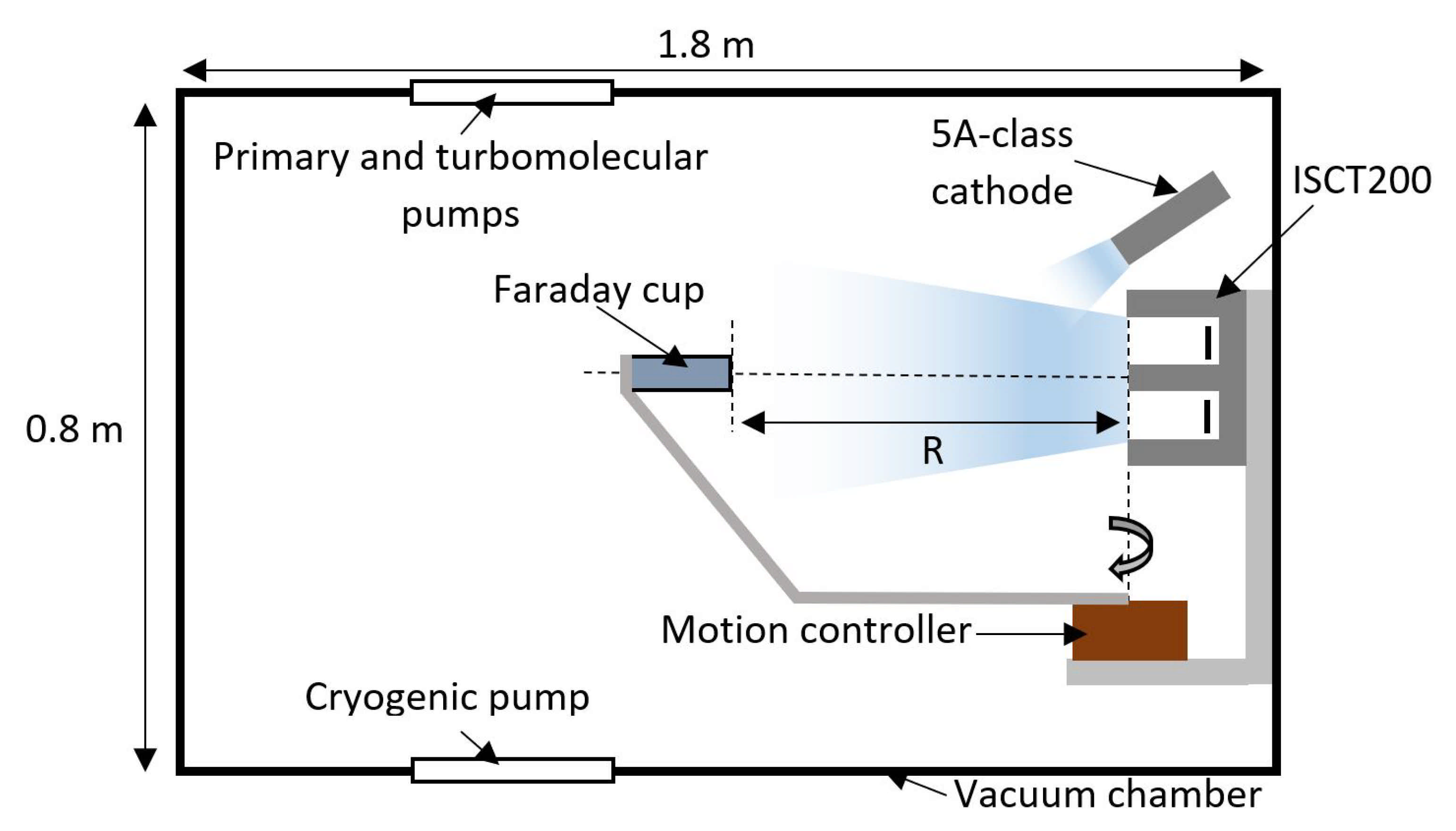

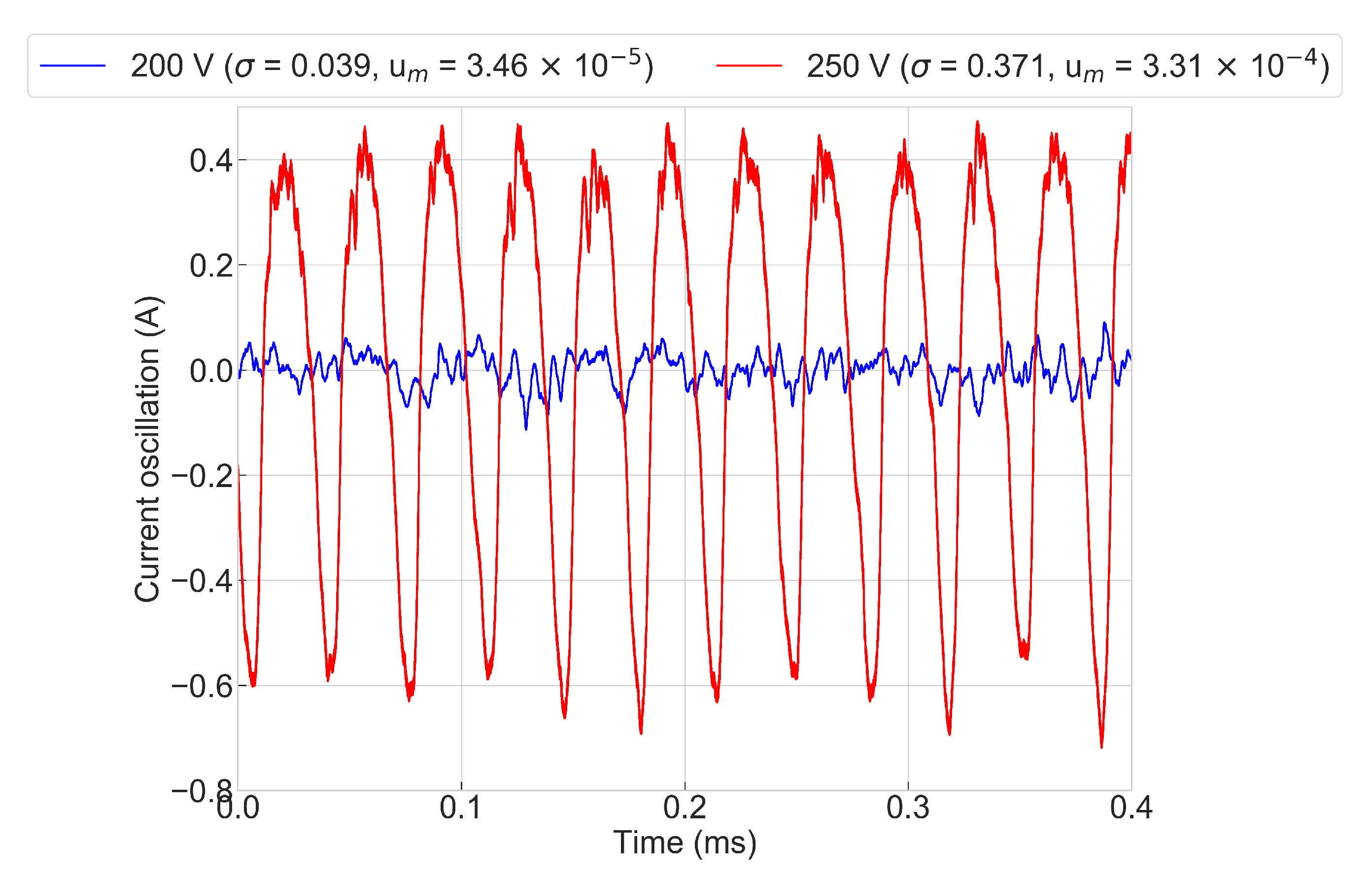

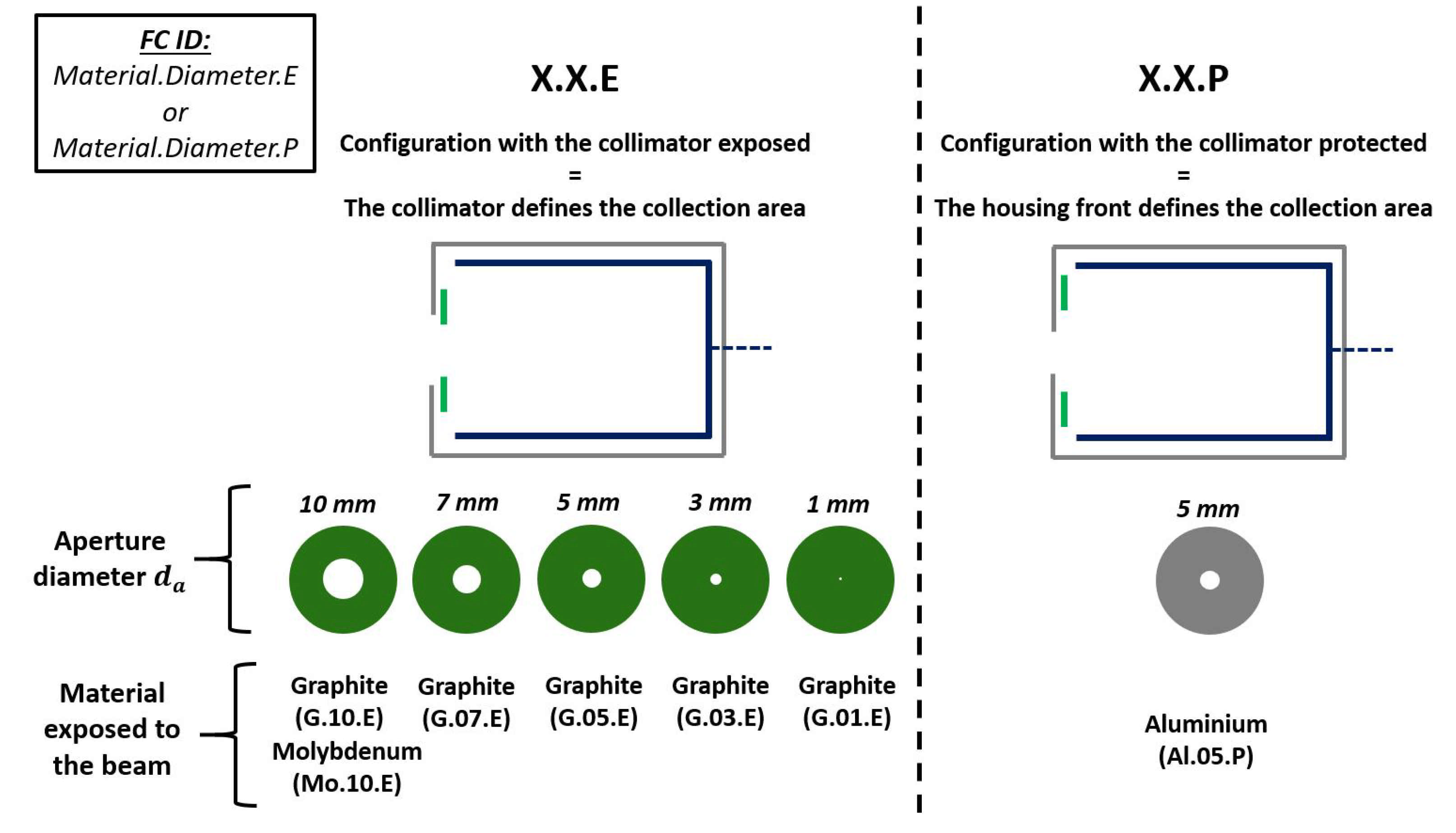

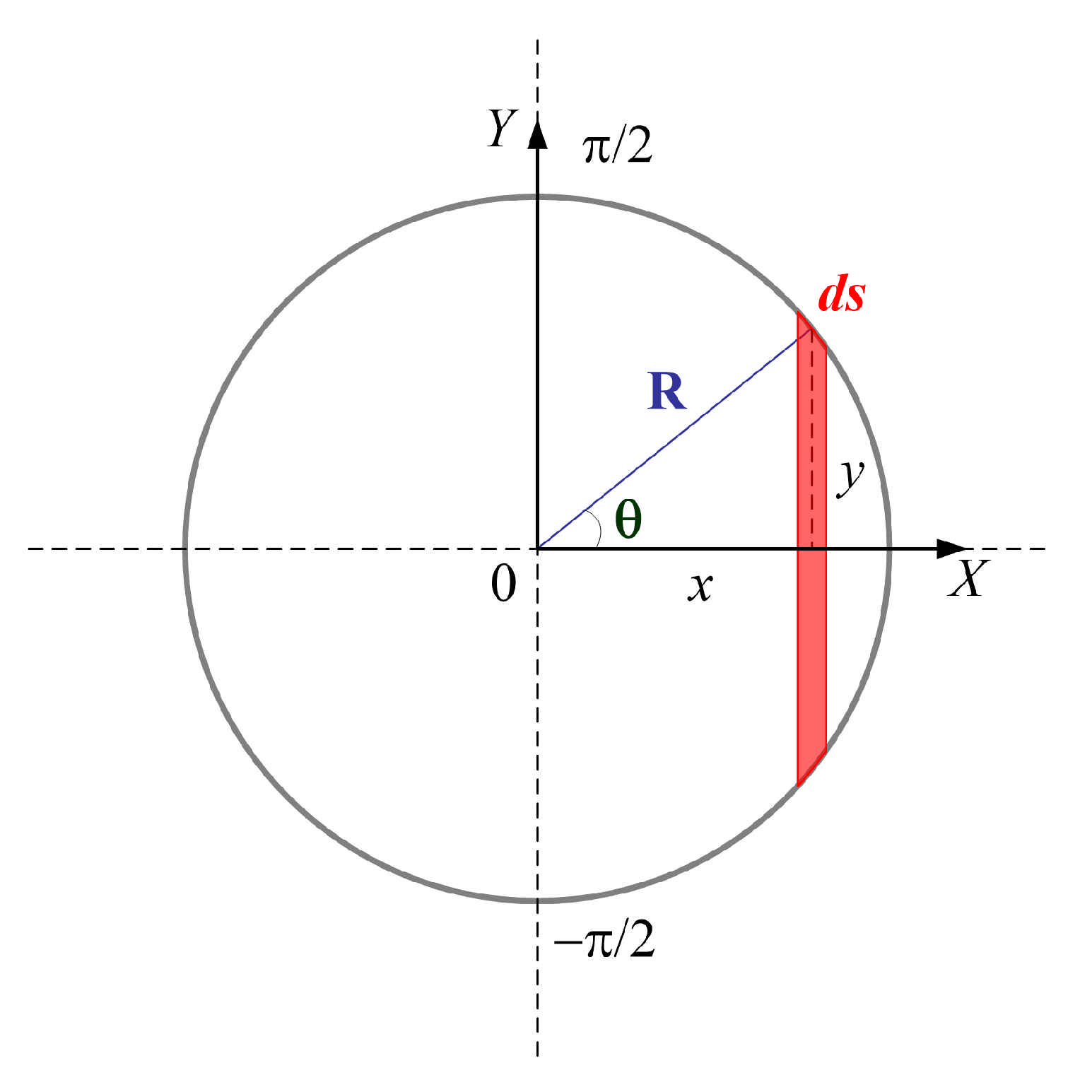
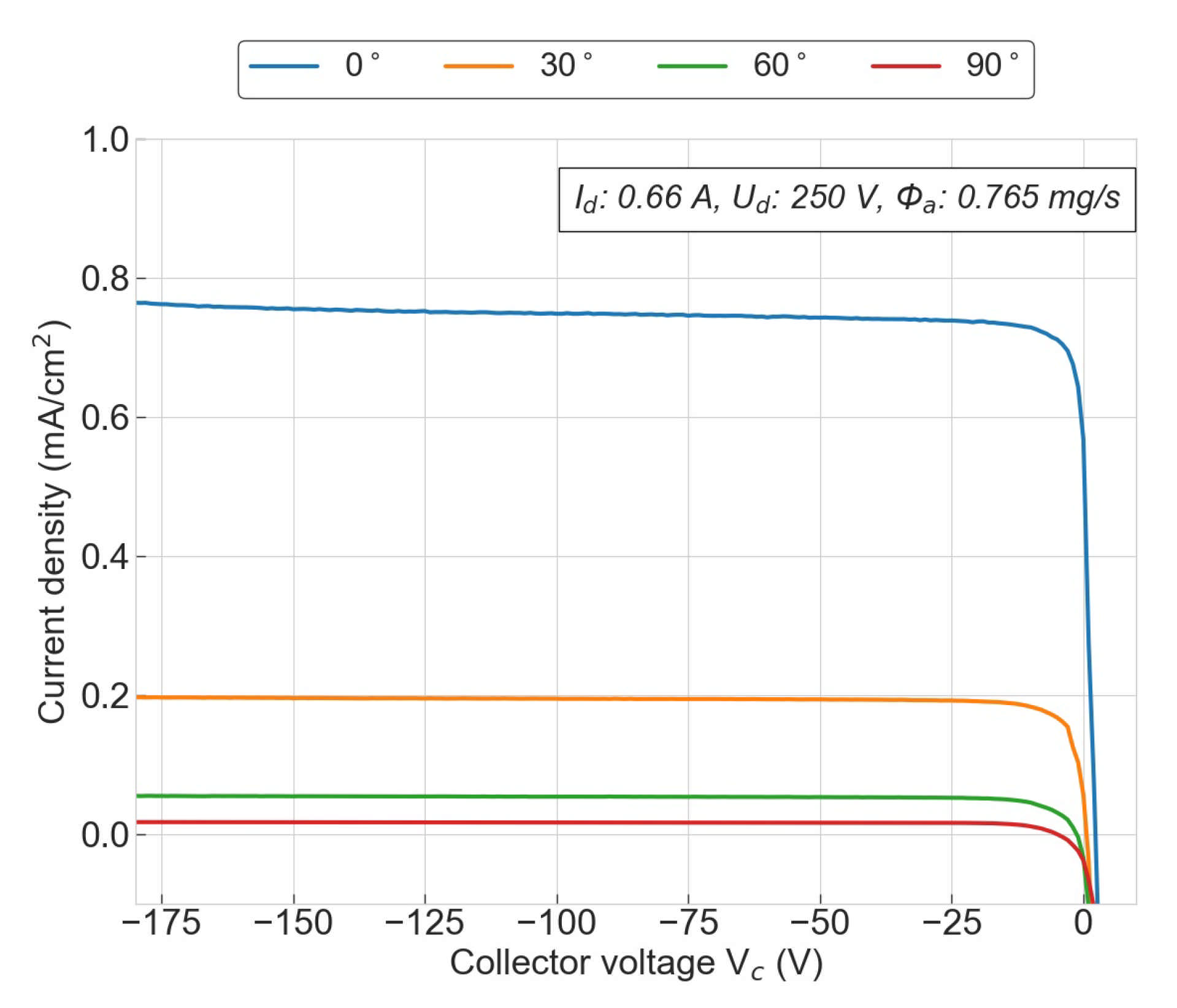
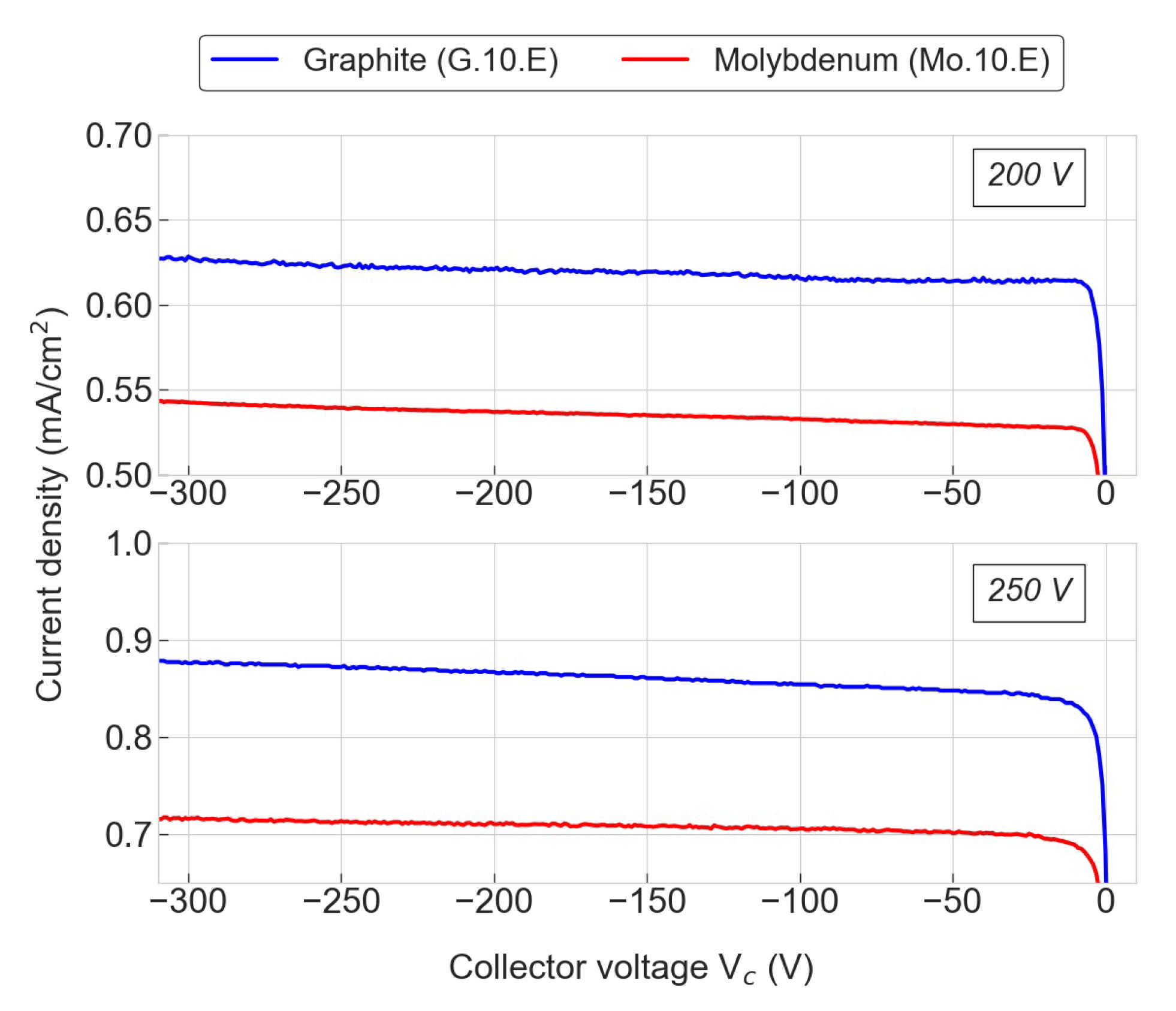

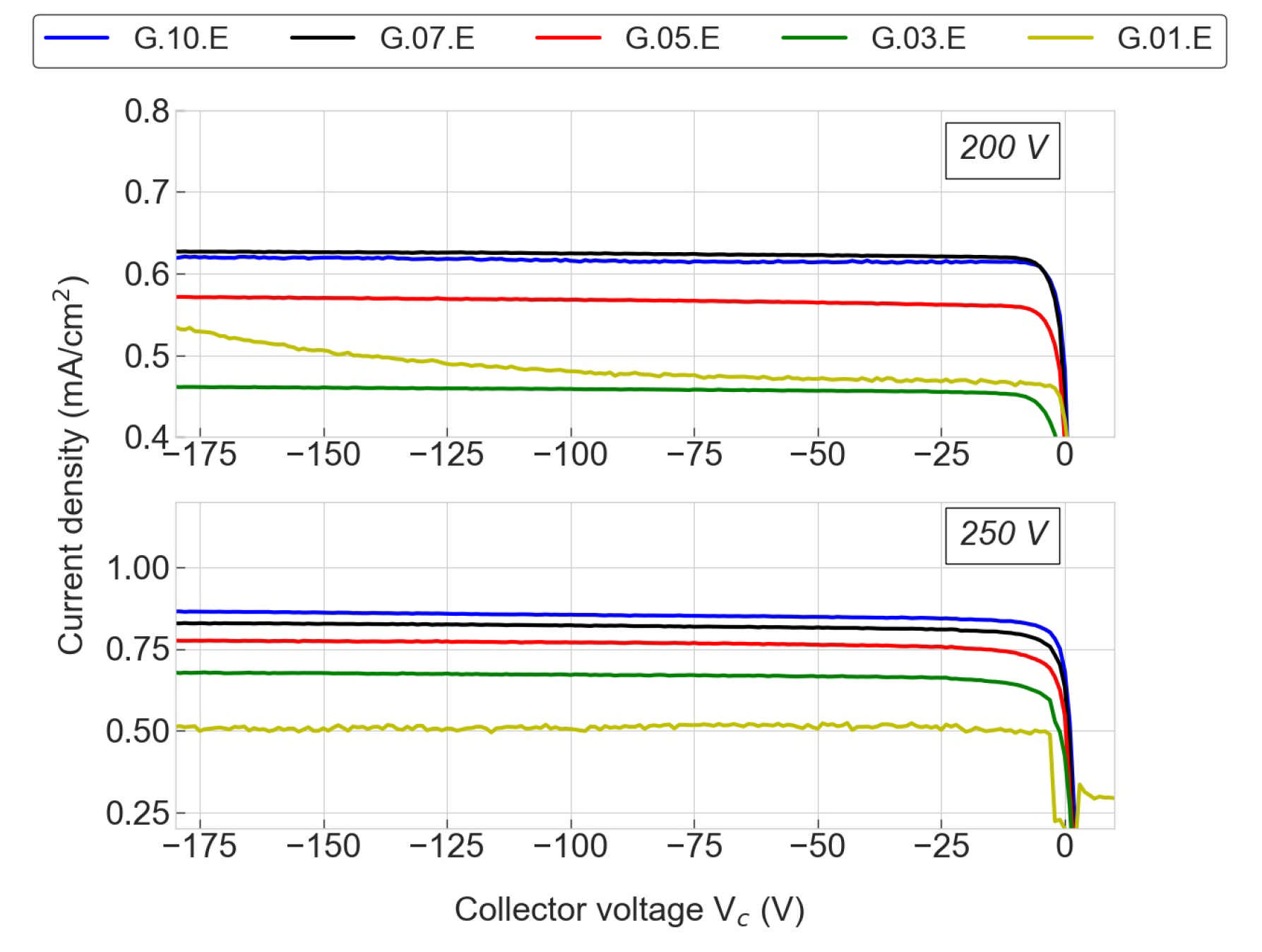
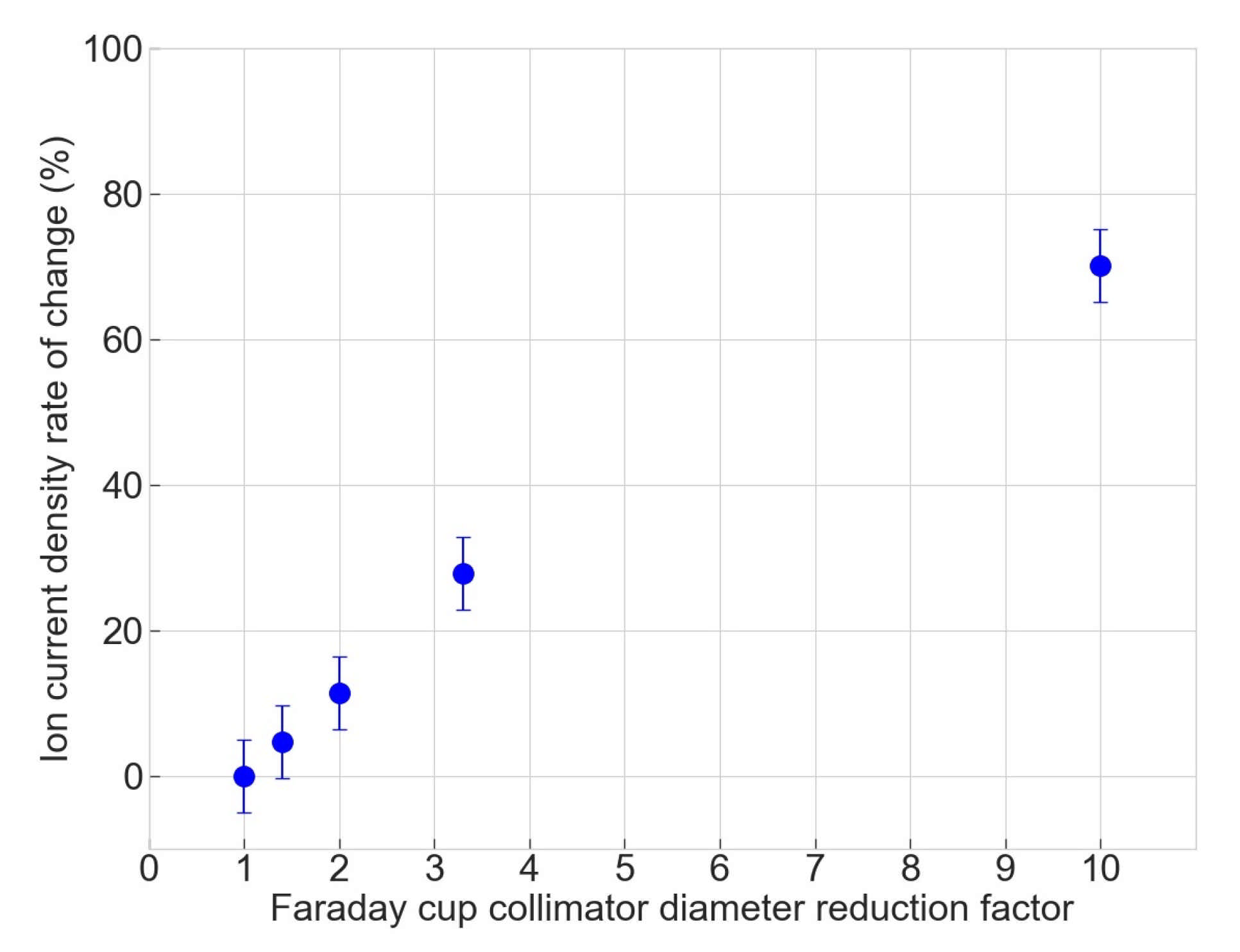

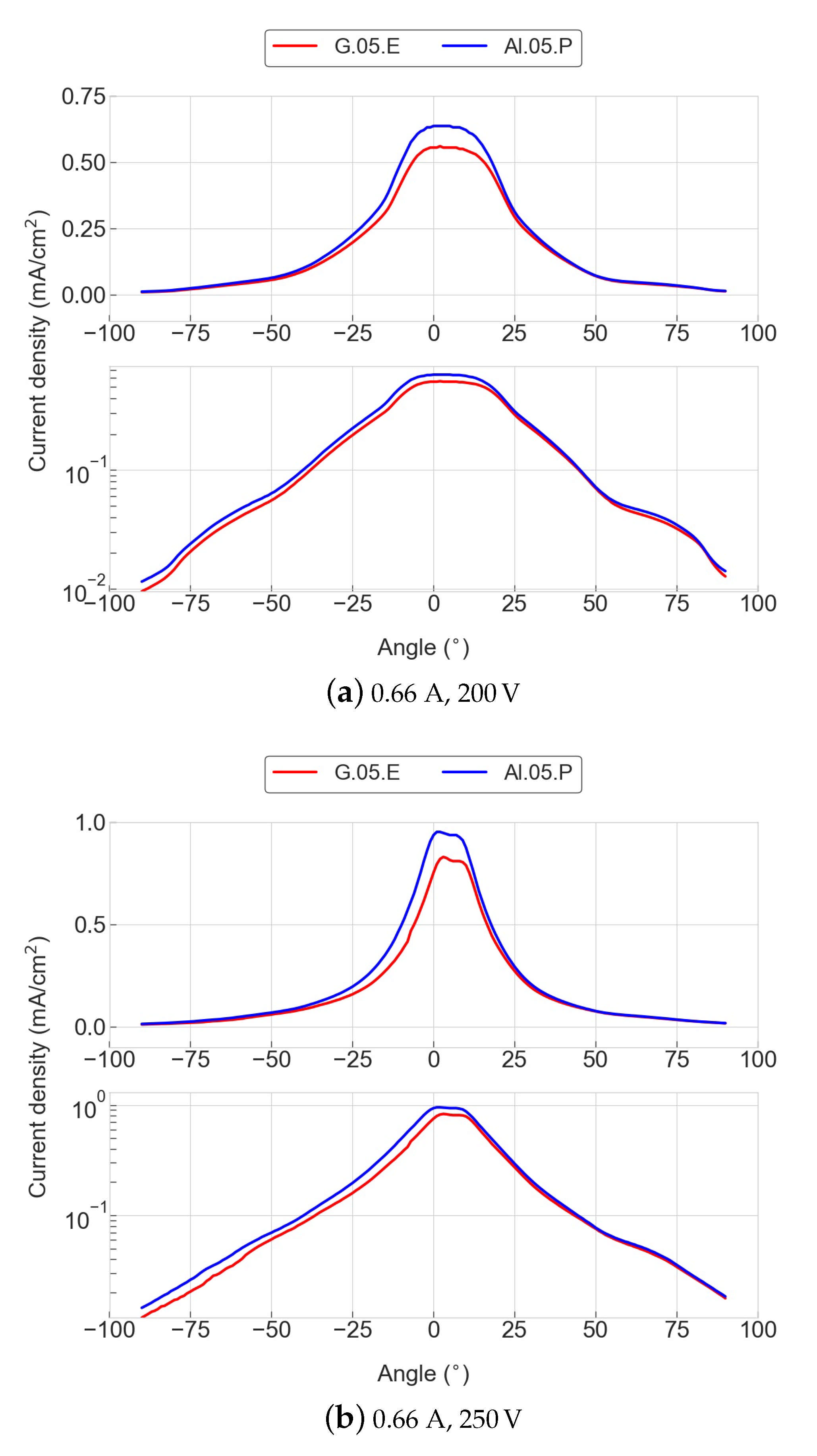
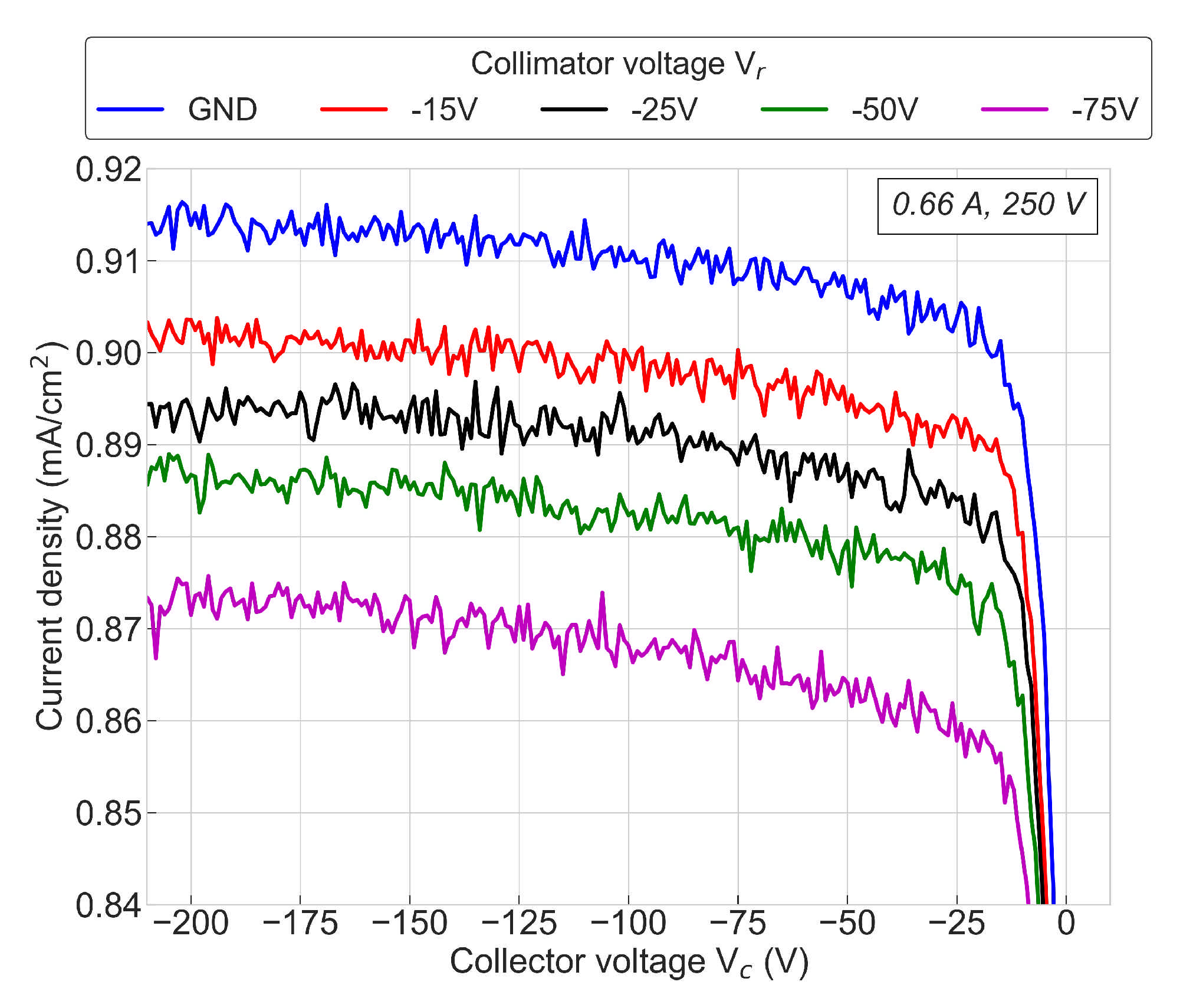




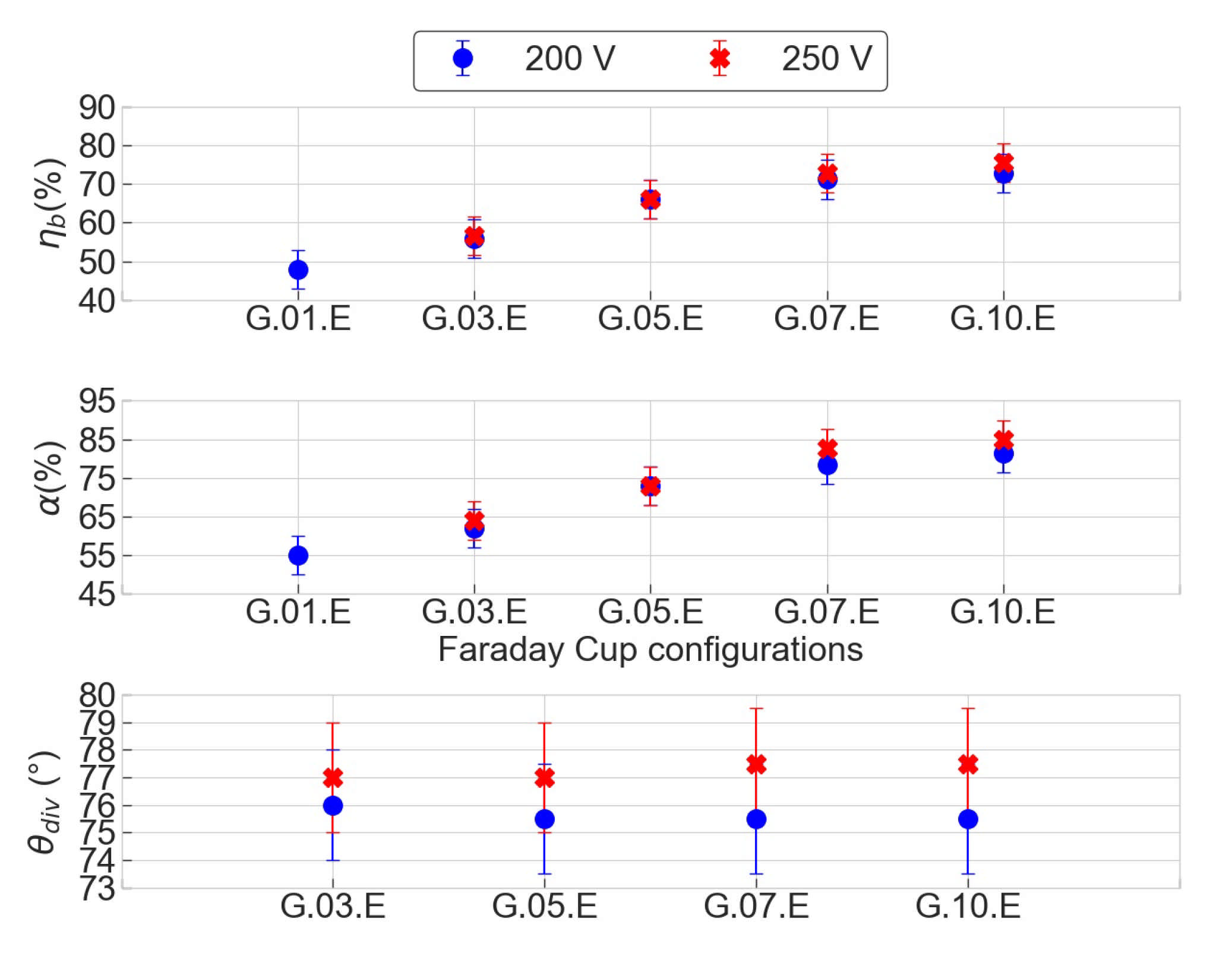
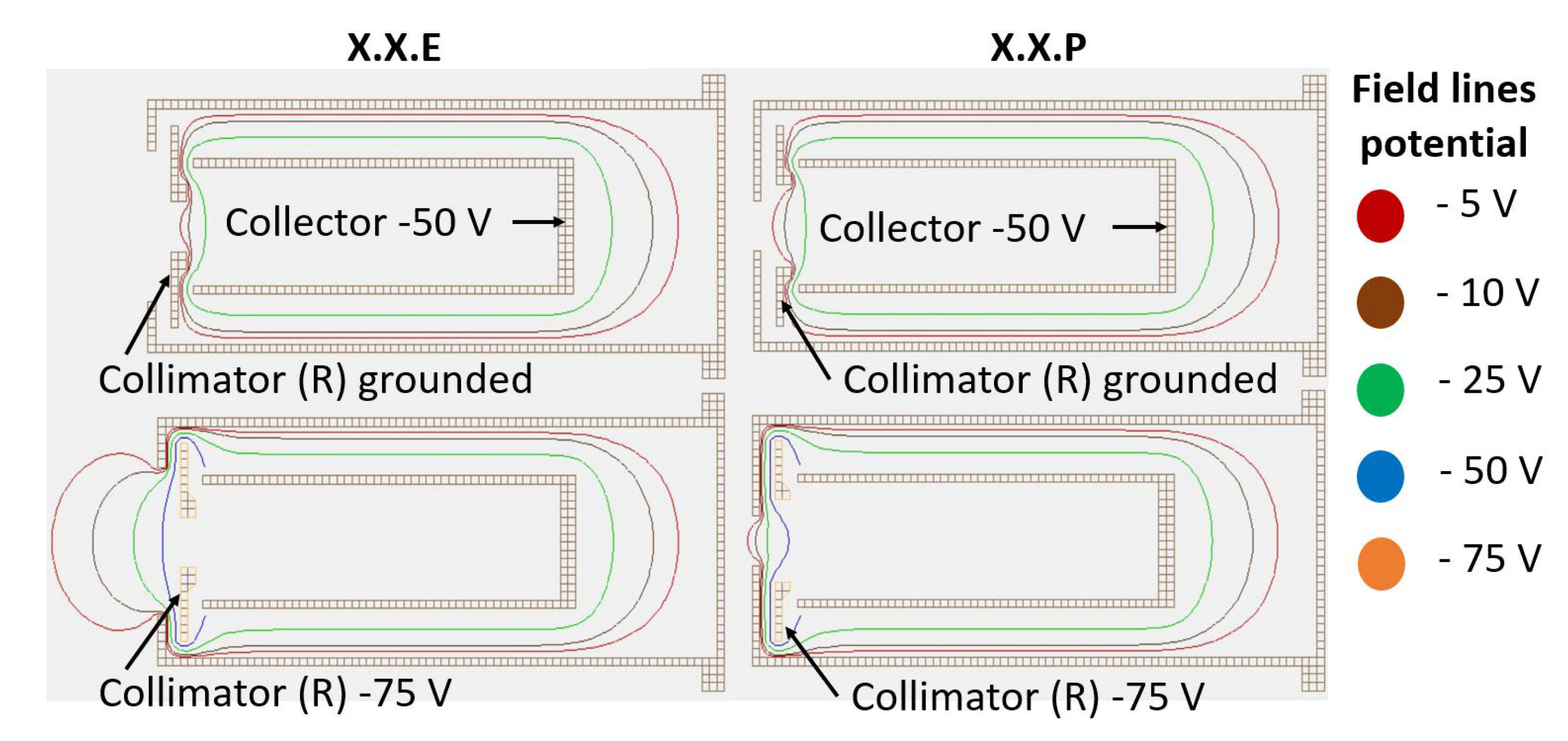
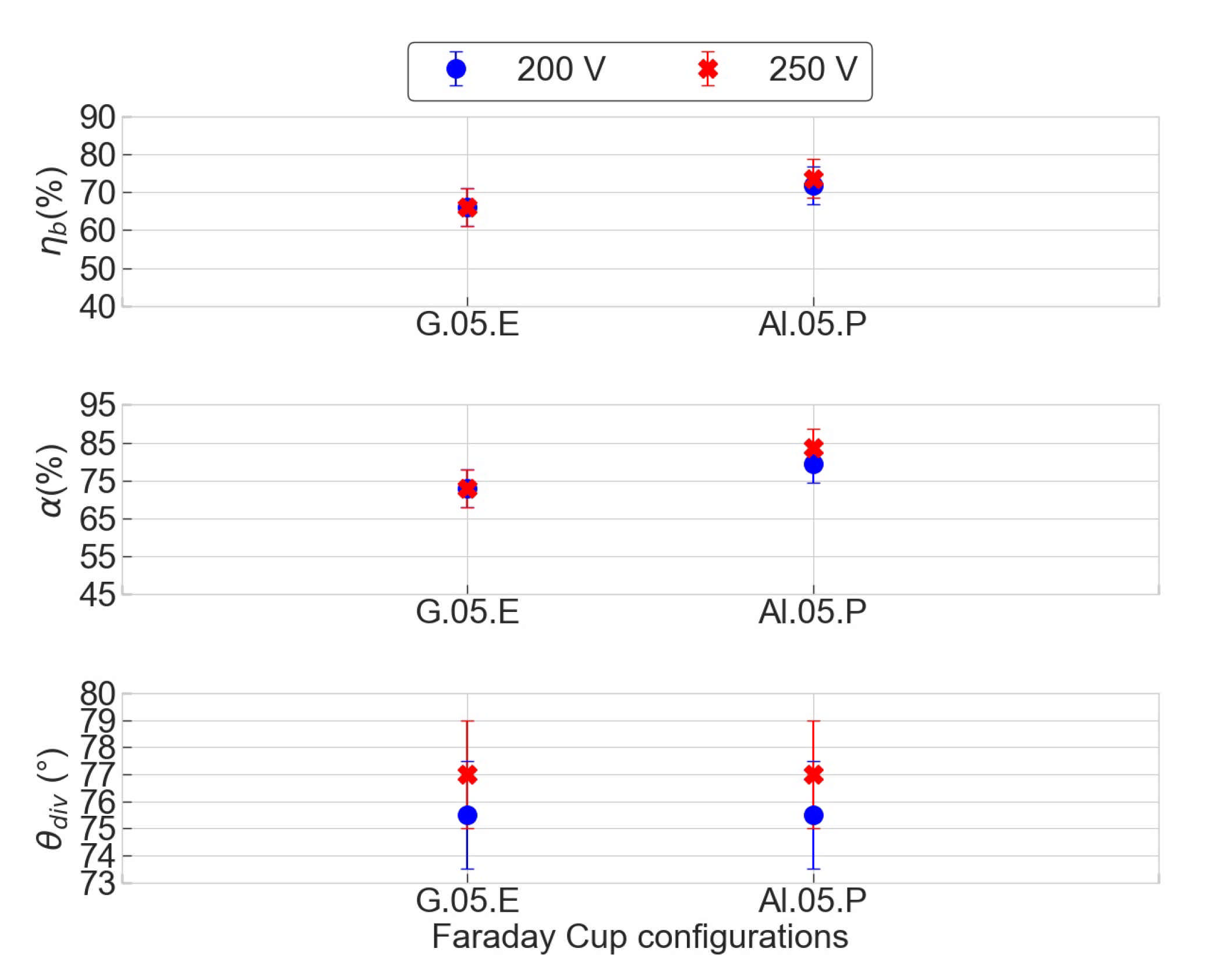



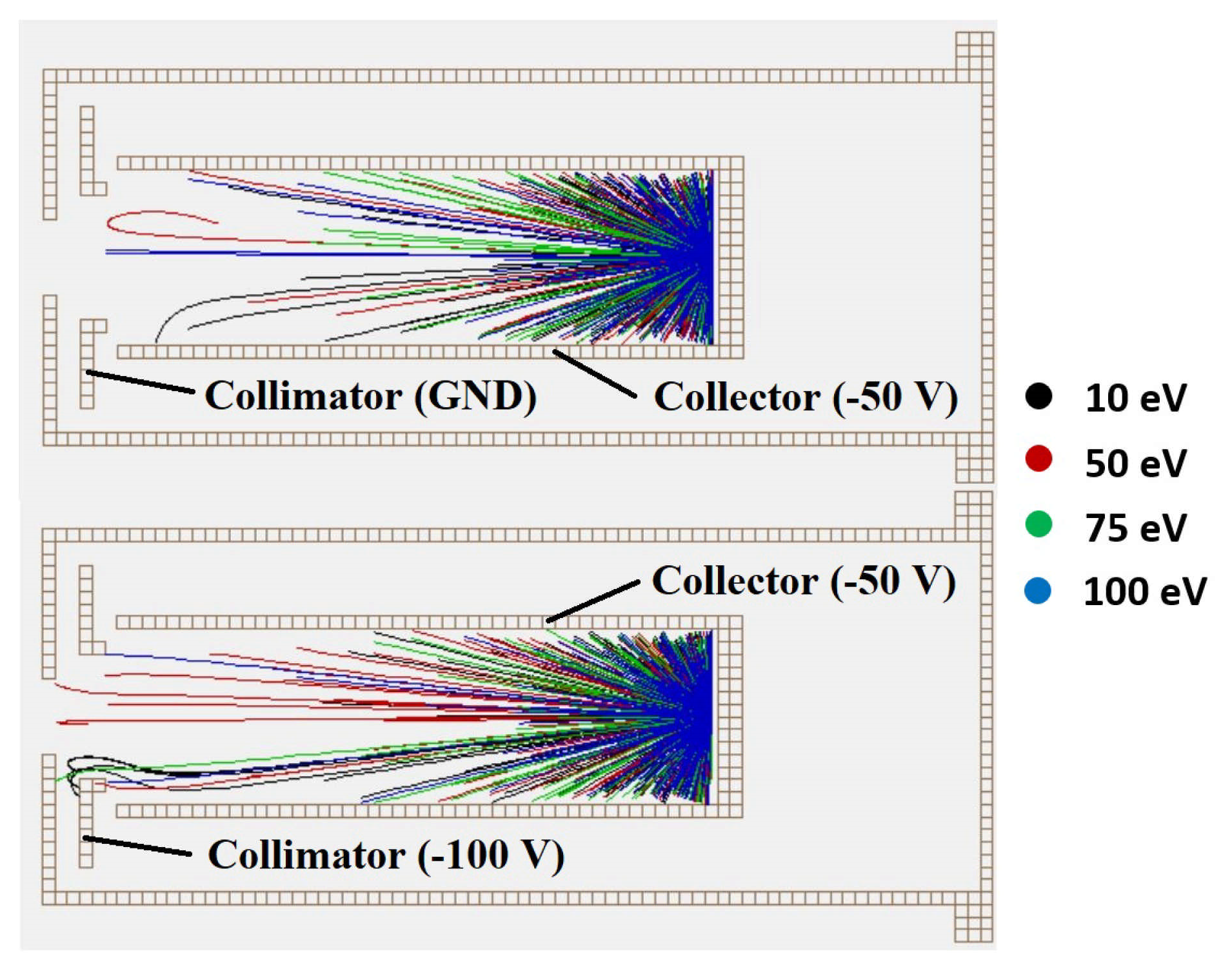
| Step | Action | Duration |
|---|---|---|
| # | # | min |
| 1 | Cathode heating (16–18 A) | 20 |
| 2 | Thruster ignition (200 V and 1 mg/s) | |
| 3 | Hall thruster stabilization | 30 |
| 4 | Setting of the operation point and stabilization | 5 |
| 5 | Measurements | |
| 6 | Next operation point and stabilization | 5 |
| Repeat step 5 and 6 if needed | ||
| 7 | Thruster shutdown | |
| 8 | Cathode shutdown |
| Discharge Voltage (U) | Discharge Current (I) | Anode Mass Flow Rate () |
|---|---|---|
| V | A | mg/s |
| 200 | 0.66 | 0.815 |
| 250 | 0.66 | 0.79 |
| Diameter | Solid Angle |
|---|---|
| mm | ° |
| 10 | 11.4 |
| 7 | 8.0 |
| 5 | 5.7 |
| 3 | 3.4 |
| 1 | 1.1 |
| Material | Sputtering Yield (200 V) | Sputtering Yield (250 V) |
|---|---|---|
| Carbon (Graphite) | 0.0018 | 0.0056 |
| Molybdenum | 0.13 | 0.18 |
| Aluminum | 0.11 | 0.16 |
Publisher’s Note: MDPI stays neutral with regard to jurisdictional claims in published maps and institutional affiliations. |
© 2021 by the authors. Licensee MDPI, Basel, Switzerland. This article is an open access article distributed under the terms and conditions of the Creative Commons Attribution (CC BY) license (http://creativecommons.org/licenses/by/4.0/).
Share and Cite
Valentin, H.; Stéphane, M. Optimization of a Faraday Cup Collimator for Electric Propulsion Device Beam Study: Case of a Hall Thruster. Appl. Sci. 2021, 11, 2419. https://doi.org/10.3390/app11052419
Valentin H, Stéphane M. Optimization of a Faraday Cup Collimator for Electric Propulsion Device Beam Study: Case of a Hall Thruster. Applied Sciences. 2021; 11(5):2419. https://doi.org/10.3390/app11052419
Chicago/Turabian StyleValentin, Hugonnaud, and Mazouffre Stéphane. 2021. "Optimization of a Faraday Cup Collimator for Electric Propulsion Device Beam Study: Case of a Hall Thruster" Applied Sciences 11, no. 5: 2419. https://doi.org/10.3390/app11052419
APA StyleValentin, H., & Stéphane, M. (2021). Optimization of a Faraday Cup Collimator for Electric Propulsion Device Beam Study: Case of a Hall Thruster. Applied Sciences, 11(5), 2419. https://doi.org/10.3390/app11052419






